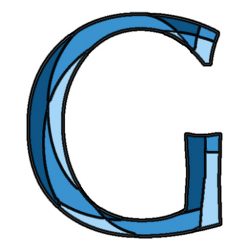Looking at my last three projects you probably wouldn’t guess that I tried out a new method for cutting and piecing my panels.
Just under two years ago, my partner and I purchased a laser cutter/engraver to complement our other small businesses. I’ve been trying to figure out a way to incorporate it in my stained glass projects. It can’t cut glass, but I’d seen some other stained glass artists use it to score glass. I tried it with absolutely no success and ruined glass.
At some point I was thinking about creating stained glass out of acrylics that I would glue together and had started to digitize some of my patterns.
Somewhere along the way, I decided to try to cut out some of my smaller patterns – the hot air balloon and the unicorn – out of plywood and MDF, just to test them out. Here is the unicorn made from 3mm thick plywood:

As I was doing this, it occurred to me that I could use these pieces not just ornamentally, but functionally. I could use the pattern I’d cut out to trace the individual pieces onto the glass.
Before this, I’d done the traditional method of using a paper pattern, placing the glass on top of whichever piece, and tracing onto the glass with a Sharpie. If the glass was dark, I’d have to use my light table (until last year, a box with an under-the-counter fluorescent light inside and a clear glass cover from an old shelving unit…last year I upgraded to an LED light pad). With this method there are always issues with accuracy, especially with very opaque glass or if my hands were particularly shaky and moved the paper or glass around as I was tracing. Plus, my eyes just aren’t what they used to be.
My first try was the unicorn. I’ve never had the unicorn come together quicker. My tracing was so accurate and as a result, so were my cutting and grinding of the pieces.
Next, I tried my Grenada Holmes piece which a kind customer had requisitioned. Here are the pieces of that pattern made from MDF:

Again, the cutting and shaping of the glass went much more quickly because my tracing was now so accurate.
Next, I made the panel of a cat’s head. This is the first pattern I drew completely on the computer and not with pencil and paper first. Here is the cut pattern out of MDF:

Even painting the cat’s pupils was easier because I was able to trace the spot with more accuracy.
I was then commissioned to make another of my XF panels. Here’s a smaller version of the one I ended up making:

And that’s another thing about this method: it’s scalable! I can cut out patterns bigger or smaller with just a few keystrokes.
Here are some photos of how the tracing goes:



What’s next?
I’ve already started to make layout frames of various sizes and shapes available for sale. These are a great tool for artists who want to create suncatchers or other smaller pieces in consistent sizes and shapes, especially for non-traditional shapes like stars or hearts, or any custom shape, really. (I’m currently selling these through Etsy)
But the potential for laser-cut patterns for stained glass artists is huge! I am working to prepare some of my own patterns converted for laser production, and I think it could be an amazing step forward for other artists as well.
Do you have a pattern that you’d like to see made into a laser-cut set of forms? Contact me! I’m interested in working with other artists to produce their patterns this way, at a very reasonable price.
